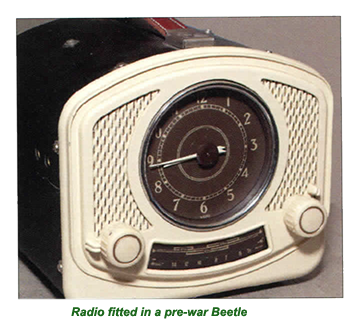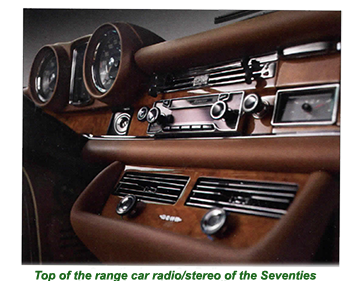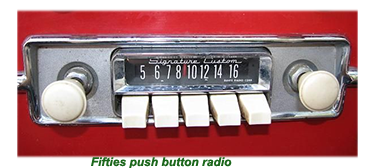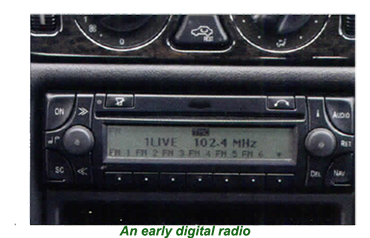 Although there may have been simpler,possibly home made, versions around earlier, the first known commercial car radio was introduced in 1930 by the Galvin Manufacturing company of Illinois, USA.
Although there may have been simpler,possibly home made, versions around earlier, the first known commercial car radio was introduced in 1930 by the Galvin Manufacturing company of Illinois, USA.
 Galvin namedd their first car radio the “Motorola.”
Galvin namedd their first car radio the “Motorola.”
 Such was the success of the Motorola car radio that the company changed their name to Motorola and went on to become a market leader in in-car entertainment.
Such was the success of the Motorola car radio that the company changed their name to Motorola and went on to become a market leader in in-car entertainment.
yDuring the mass production explosion in the car industry of the Fifties and Sixties, several significant developments in in-car entertainment were released.
The first came in 1952 with the release of FM radio, followed the next year by FM. Progress was rapid in the early Fifties, with West German audio giants Becker introducing the first car radio that boasted an AM/ FM permutation.
By the early Sixties, in-car transistor radios were becoming the norm, with trailblazer Becker becoming the first to offer a “solid-state” radio with no vacuum tubes.
 The next stage in in-car development came in 1965 with the introduction of the Eight-Track Tape Player.
The next stage in in-car development came in 1965 with the introduction of the Eight-Track Tape Player.
Anyone restoring a classic car of these times has to make their choices.
If there already is a radio or stereo fitted in the vehicle, the chances are that more or less certainit will no longer be in working order.
![]()
At this point, the restorer is faced with some simple choices.
- Should they make an effort to discover if the radio is worthy of repair or restoration? If this is the case, then the restorer is faced with two choices. E
 ither to restore it themselves- a long and prodigious task or handing it on one of the numerous specialists who handle the repair and maintenance of historic radios, to go as far as upgrading them to meet modern standards and will even reinstall them- at a hefty coast.
ither to restore it themselves- a long and prodigious task or handing it on one of the numerous specialists who handle the repair and maintenance of historic radios, to go as far as upgrading them to meet modern standards and will even reinstall them- at a hefty coast.
- Replace it with a sound system that looks vintage but provides the best of in-car entertainment available today. If the restorer is less concerned with the authenticity of interior restoration, then the options are pretty well unlimited. In-car entertainment specialists will advise on the best system to meet particular audio quality requirements or whether there will be a need to invest in an amplifier and even a subwoofer.
Even if the terminology were unheard of when the car was first produced, today’s in-car entertainment specialists would be capable of integrating them into a classic vehicle using techniques that will mean they will be totally unobtrusive in the décor.
![]()
Once the style of the sound system has been settled, the next issue is to match up the wiring system so that it will be compatible.
 The original radio will have been wired up to work on a 6-volt supply system, while even the least powerful radio will require a 12-volt system to power it.
The original radio will have been wired up to work on a 6-volt supply system, while even the least powerful radio will require a 12-volt system to power it.
 This problem is easily solvable by investing in a transformer that will convert 6-volt voltage to 12 volts.
This problem is easily solvable by investing in a transformer that will convert 6-volt voltage to 12 volts.
 As the restorer will inevitably discover when working on the car’s wiring system, the insulation on the original wiring will have become stiff and brittle and needing to be changed.
As the restorer will inevitably discover when working on the car’s wiring system, the insulation on the original wiring will have become stiff and brittle and needing to be changed.
The wiring used in a car produced half a century ago or more was insulated with rubber,then lacquered.
These materials were biodegradable, and totally failed to stand the test of time, pretty soon requiring complete replacement.
int 4

